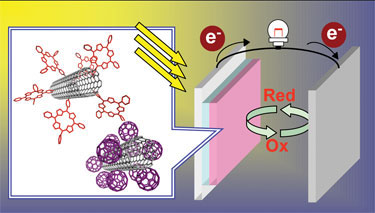| Posted: June 22, 2008 |
Solar energy turns organic |
|
(Nanowerk News) Cheap and efficient conversion of solar energy into electricity could help combat global warming and the shortage of fossil fuels. However, the high production cost of electricity from silicon-based solar cells has limited the use of the technology. Low cost solar cells with high cell performance are highly desirable and organic solar cells could be the answer. They are easy to make from inexpensive organic materials and, unlike inorganic solar cells, are lightweight, flexible and colourful.
|
|
Light absorption by organic solar cells leads to an excitation state known as an exciton or electron-hole pair. The electrons and holes are separated from each other and carried through donor and acceptor molecules to the electrodes, generating a photocurrent. This process of converting light directly into electricity is known as photovoltaics and it must be optimised for organic solar cells to be efficient. Much effort has been devoted to finding suitable donor and acceptor molecules and organising them on an electrode surface at the nanometre scale.
|
 |
| Carbon nanotubes' wire-like structures help them form charge-transporting highways in organic solar cells
|
|
Fullerenes and their derivatives have been widely used as excellent acceptor molecules. More recently, carbon nanotubes (CNTs), which have a similar carbon-based structure, have attracted much attention. In contrast to the spherical shape of fullerenes, CNTs have a one dimensional, wire-like structure, which make them better at forming electron- or hole-transporting highways in the cell. Their large surface area enhances the separation of the electron-hole pair and they show conductivity several times greater than that of conducting polymers. Also, CNTs can act as both electron donors and acceptors depending on the redox properties of the other component in the cell. All of these features make CNTs promising candidates for charge separation and transport in organic solar cells.
|
|
A number of scientists have made photoelectrochemical devices or photovoltaic cells with CNT-modified electrodes. They have used a variety of methods, including layer-by-layer deposition and spray-coating, to organise the CNTs with suitable donor or acceptor molecules on electrode surfaces. At present, however, the energy conversion efficiency of CNT-modified electrodes has yet to reach the levels of high performance dye-sensitised solar cells - which use porous, nanocrystalline titanium dioxide electrodes sensitised with ruthenium dyes - or bulk heterojunction solar cells, which use conjugated polymers and functionalised fullerenes.
|
|
At present, it is difficult to synthesise pure CNTs with a consistent structure. To improve CNT-based solar cells, scientists may have to purify or sort out the CNTs with the best structure for charge transport. Alternatively, a fascinating approach is to use CNTs as nanoscaffolds for donor or acceptor molecules to construct charge-transporting highways.
|
|
The history of CNT-based organic solar cells is less than 10 years old. A great deal of work still has to be done to bring out their full potential for solar energy conversion.
|
|
Read Hiroshi Imahori and Tomokazu Umeyama's Feature Article ("Carbon nanotube-modified electrodes for solar energy conversion"; free access article) in Energy & Environmental Science, the new journal from RSC Publishing launching in July 2008.
|

